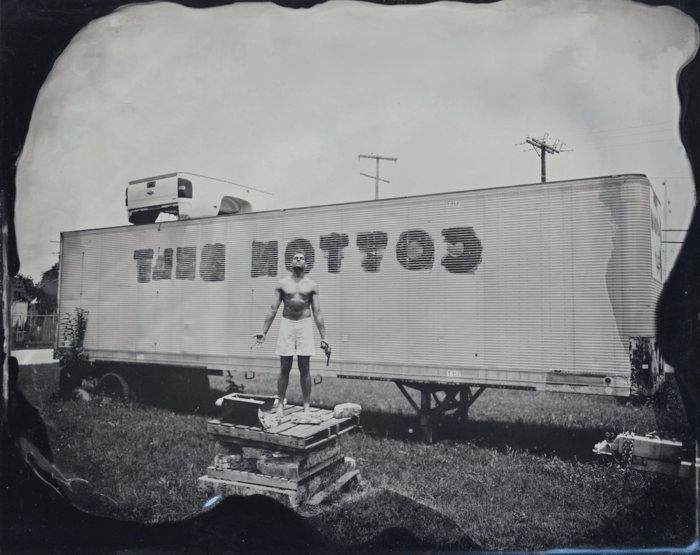Media Release
September 18, 2020
Shelter in Place, Rain or Shine Outdoor Opening, October 1, 4-6pm, brief remarks at 5pm
High res images available here
Media contact: Rebecca Biggs, Communications Manager, 503-226-3600, bbiggs@ojmche.org
Oregon Jewish Museum and Center for Holocaust Education, 724 NW Davis Street, Portland
Installation viewable from the exterior of OJMCHE both during the day and at night
Social artist and activist Adam W. McKinney opens Shelter in Place in the windows and first floor gallery of Oregon Jewish Museum and Center for Holocaust Education on the eve of the Jewish holiday of Sukkot, October 1, 2020. Shelter in Place, which in its entirety is viewable from the sidewalk surrounding the museum, is a film, photography, and dance-based interrogation of the social tenets of Sukkot—departing and dwelling, expressing and atoning, striking and shaking. A Black Jewish response to histories of oppression, McKinney’s Shelter in Place is an inquiry into social isolation and the physical and emotional effects of anti-Black racial violence. While the museum is closed, the multimedia installation extends into the museum’s first floor gallery and windows and is completely viewable both day and night from the sidewalk.
“We are thrilled to have Adam W. McKinney’s work enlivening our first floor gallery and windows with an installation that speaks to Jewish tradition and concepts of home and harvest, while also asking profound questions of who gets to feel secure and safe and have a sense of place,” said OJMCHE Director Judy Margles. “We are most grateful to the support of the Council of American Jewish Museums, Asylum Arts, and CANVAS for creating this unique opportunity to turn the museum ‘inside out’ with this exhibition that is relevant both in content and accessibility.”
With Shelter in Place, McKinney deconstructs the idea of the sukkah, the temporary dwelling built adjacent to Jewish homes for Sukkot, laying bare the internal tensions of these contemporary moments in history. McKinney shares, “My role as an artist is to bring awareness to the impact of oppression and to the vestiges of historical trauma. I am interested in thinking about might be on the other side of trauma—and it must be each other. My work is rooted in what I call ‘the aesthetics of liberation.’ I ask, ‘How do we move in the direction of liberation and ‘How do we heal?'”
McKinney’s creative research on the lynching of Mr. Fred Rouse (d. 12.11.1921) produced a collaboration with Navajo photographer Will Wilson in which McKinney sat for tintype photographs dressed as Rouse in the traumatic sites associated with his lynching. McKinney uses tintype photography as a way to confuse the viewer and to investigate memory (“What, how, and why do we remember?”), thereby problematizing the narrow, liminal spaces between past and present violent acts against Black bodies. “Because I could not locate any photographs of Mr. Rouse,” he says, “I took it upon myself to ‘fill in the blanks’ and use my body as the canvas on which I would remember him.” Three of the printed tintypes will be included in the installation.
Adam W. McKinney lives in Fort Worth, TX with his husband Daniel Banks, where he is an Assistant Professor of Dance at Texas Christian University.
Born into, and a product of, the American Civil Rights movement, his parents, one of African and Native American heritages and one of Eastern European Jewish heritages, were married in July 1964—three years before Loving v. Virginia, when the Supreme Court of the United States struck down state laws banning interracial marriage, and 29 days after President Lyndon B. Johnson signed the Civil Rights Act, which outlawed discrimination based on race, color, religion, sex, and national origin.
McKinney says, “I was raised in an environment where being of mixed heritages was not an anomaly, nor a contradiction. Being “mixed” in the 1980s was, in fact, normalizing. Rather than a severed, percentaged representation of any one of my heritages, I was taught that I am 100% of all of my heritages, or, as is said in Lakota, “Mitákuye Oyás’i”—a reflection of “all my relatives.” My internal, multi-dimensional understanding of myself is externalized in the ways in which I approach my art making processes. With my work, I attempt to affirm the fullness of humanity and the infinite possibilities that abound when the promise of liberation is at the forefront of our collective hearts, minds, and relationships.”
Shelter in Place is a collaboration of Asylum Arts and the Oregon Jewish Museum and Center for Holocaust Education, made possible with the generous support of CANVAS. The work is part of the national project – Dwelling in a Time of Plagues – which makes new outdoor art possible at museum sites, with organizational support from the Council of American Jewish Museums.
